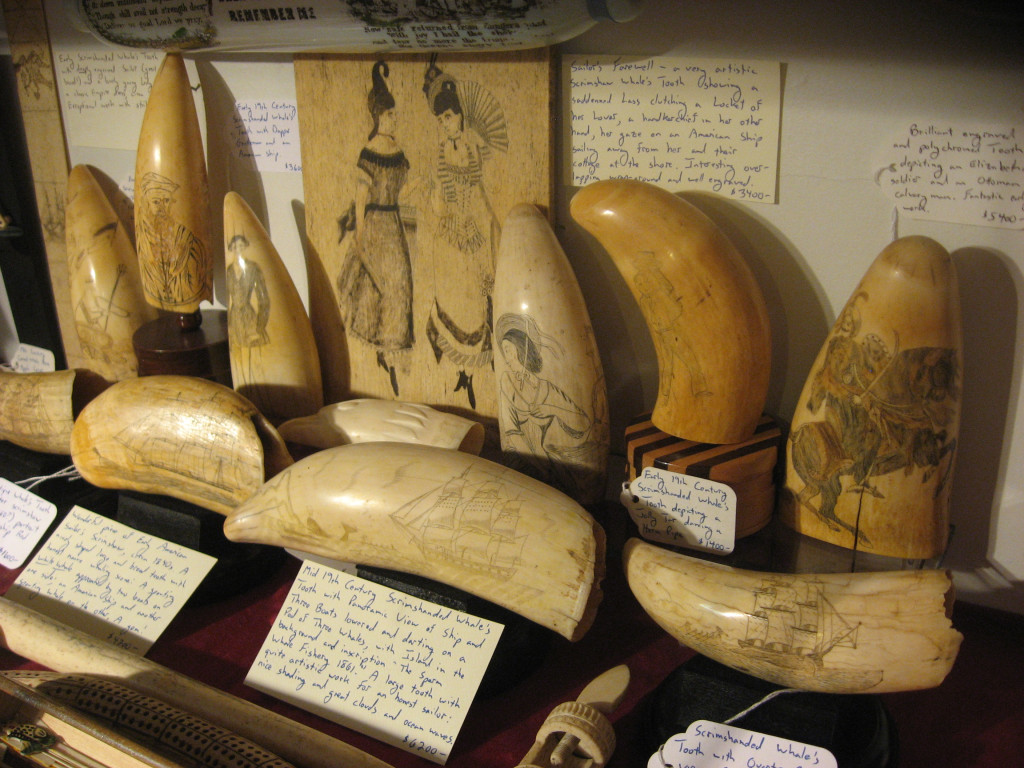
Scrimshaw has caught headlines in the last couple of years, and people coming through our shop are often bursting with questions about this old art. They have heard in the news about people getting arrested, reports of smuggling, people going to jail. They want to know exactly what is scrimshaw? Was it done in America? How can you tell a genuine antique piece from an imposter? For that matter how can you be sure of the material: is it ivory, bone or fake? Above all everyone wants to know about the laws. Is it still legal to buy and sell scrimshaw? Is it ethical to collect?

Scrimshaw is one of the great classic antiques of New England, as indigenous and evocative as Elmer Crowell decoys, Townsend furniture, the crafts from Canterbury, Sabbathday Lake and other early Shaker communities, and the folk art and primitives from across the Northern states. Much in the same way that Moby Dick is one of the greatest American novels and one of our signature contributions to world literature, scrimshaw itself is regarded as a quintessential American tradition among the great folk art of the world.

The history of scrimshaw is bit foggy. The word itself comes from Scandinavia and means… eh, we’re not really sure. The definition seems to have been lost in the scuppers long, long ago. There are a few theories kicking about, but the consensus leans towards a meaning akin to killing time or horsing around. The idea is that when it came to sailors, their idle hands got up to something no more devilish than whittling, or more precisely in this case, scratching and engraving images on pieces of scrap ivory or bone.
There is of course an unbroken tradition of working with ivory and bone among many native peoples across North America and Eurasia. There have also been skilled ivory artisans in many European countries as far back as the Middle Ages and the Renaissance: Dieppe and Augsburg in particular, but also Scandinavia, Russia, Southern Germany and Italy. Nevertheless scrimshaw as we have come to know it today is overwhelmingly American. Scrimshaw is intimately tied to the historic culture and lore of the whalers under sail; the scrimshanders themselves and their art was unique and very different from what was seen with elephant ivory.

So what exactly are we talking about here? To the purist Scrimshaw refers only to pieces of marine ivory or bone engraved by sailors on board ship. Some of the ultra-orthodox would further insist that only pieces crafted by American sailors qualify. Most serious collectors would insist that proper scrimshaw must be on a whale’s tooth, walrus tusk, baleen or piece of bone from a whale or some other marine mammal. Some collectors will make a distinction between proper scrimshaw and pieces that were carved rather than engraved. Most all collectors recognize a difference between scrimshaw and Napoleonic prisoner of war pieces made from soup bone.
I’m a bit more liberal. I don’t think a sailor onboard the Charles W Morgan back in the 1850s would have made a distinction between the scratching he was doing on a sperm whale tooth and what he had done on a piece of horn or antler… or ostrich egg… or coconut shell… or even a handy piece of hard tropic wood. I think that same sailor would question your sanity if you suggested that his work was genuine, but not any work done by a whaler out of Cornwall or Brest. And I am sure that same sailor would want to shanghai a taste of whatever grog you were sipping if you tried to tell him the pieces he made while dockside or elsewhere ashore wasn’t real scrimshaw. We have to realize that every aspect of sailors’ lives, both ashore and at sea, and all they experience, manifests itself and breathes life into their folk art.
In part two we’ll look at how to identify a genuine piece of scrimshaw.
